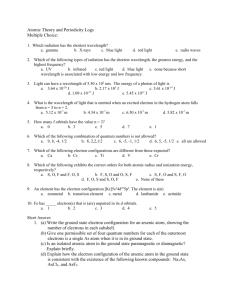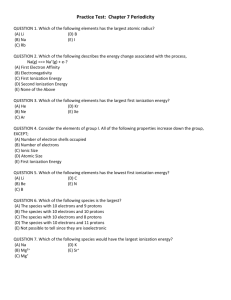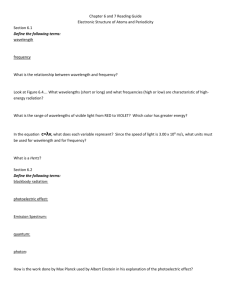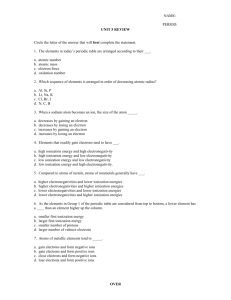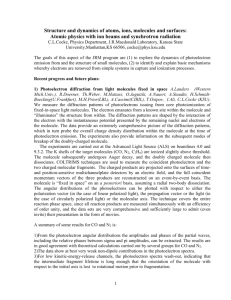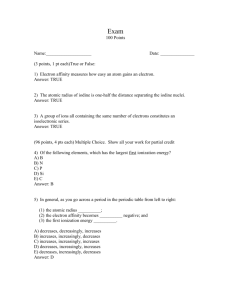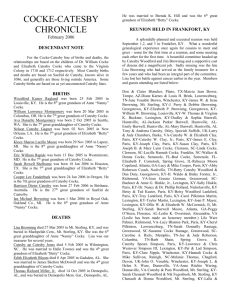Atomic Physics with Highly Charged Ions : Low Velocity
advertisement
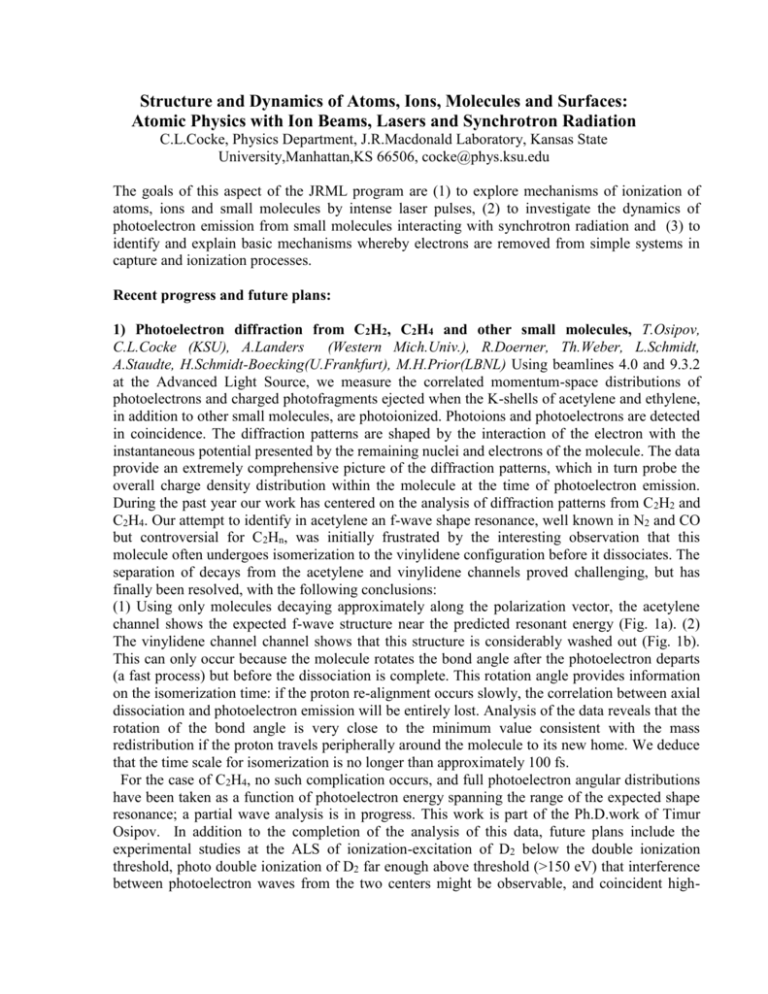
Structure and Dynamics of Atoms, Ions, Molecules and Surfaces: Atomic Physics with Ion Beams, Lasers and Synchrotron Radiation C.L.Cocke, Physics Department, J.R.Macdonald Laboratory, Kansas State University,Manhattan,KS 66506, cocke@phys.ksu.edu The goals of this aspect of the JRML program are (1) to explore mechanisms of ionization of atoms, ions and small molecules by intense laser pulses, (2) to investigate the dynamics of photoelectron emission from small molecules interacting with synchrotron radiation and (3) to identify and explain basic mechanisms whereby electrons are removed from simple systems in capture and ionization processes. Recent progress and future plans: 1) Photoelectron diffraction from C2H2, C2H4 and other small molecules, T.Osipov, C.L.Cocke (KSU), A.Landers (Western Mich.Univ.), R.Doerner, Th.Weber, L.Schmidt, A.Staudte, H.Schmidt-Boecking(U.Frankfurt), M.H.Prior(LBNL) Using beamlines 4.0 and 9.3.2 at the Advanced Light Source, we measure the correlated momentum-space distributions of photoelectrons and charged photofragments ejected when the K-shells of acetylene and ethylene, in addition to other small molecules, are photoionized. Photoions and photoelectrons are detected in coincidence. The diffraction patterns are shaped by the interaction of the electron with the instantaneous potential presented by the remaining nuclei and electrons of the molecule. The data provide an extremely comprehensive picture of the diffraction patterns, which in turn probe the overall charge density distribution within the molecule at the time of photoelectron emission. During the past year our work has centered on the analysis of diffraction patterns from C 2H2 and C2H4. Our attempt to identify in acetylene an f-wave shape resonance, well known in N2 and CO but controversial for C2Hn, was initially frustrated by the interesting observation that this molecule often undergoes isomerization to the vinylidene configuration before it dissociates. The separation of decays from the acetylene and vinylidene channels proved challenging, but has finally been resolved, with the following conclusions: (1) Using only molecules decaying approximately along the polarization vector, the acetylene channel shows the expected f-wave structure near the predicted resonant energy (Fig. 1a). (2) The vinylidene channel channel shows that this structure is considerably washed out (Fig. 1b). This can only occur because the molecule rotates the bond angle after the photoelectron departs (a fast process) but before the dissociation is complete. This rotation angle provides information on the isomerization time: if the proton re-alignment occurs slowly, the correlation between axial dissociation and photoelectron emission will be entirely lost. Analysis of the data reveals that the rotation of the bond angle is very close to the minimum value consistent with the mass redistribution if the proton travels peripherally around the molecule to its new home. We deduce that the time scale for isomerization is no longer than approximately 100 fs. For the case of C2H4, no such complication occurs, and full photoelectron angular distributions have been taken as a function of photoelectron energy spanning the range of the expected shape resonance; a partial wave analysis is in progress. This work is part of the Ph.D.work of Timur Osipov. In addition to the completion of the analysis of this data, future plans include the experimental studies at the ALS of ionization-excitation of D2 below the double ionization threshold, photo double ionization of D2 far enough above threshold (>150 eV) that interference between photoelectron waves from the two centers might be observable, and coincident high- resolution-Auger/photoelectron/KER experiments for which the limits of the validity of the twostep picture of Auger and dissociation process may be probed. Acetylene Vinylidene (a) (b) Fig.1. Angular distributions of photoelectrons from acetylene photoionized by 309 eV photons, for decay into the CH+/CH+ channel (a) and CH2+/C+ channel (b). The electron emission angle is measured relative to the dissociation axis, which is required to lie near the polarization axis. 2) COLTRIMS measurements of electron capture from and low energy ionization of atomic H E. Edgu-Fry and C. L. Cocke The goal of this project is to establish an atomic hydrogen source compatible with use in a COLTRIMS experiment. It will be used to identify and characterize as cleanly as possible the process whereby a slow charged projectile promotes into the continuum an electron from a neutral target. For this case, the projectile velocity is sufficiently low that direct kinematic ionization is forbidden, and saddle-point electron promotion, in some form, is expected to the major process. In addition, electron capture from atomic hydrogen by multiply charged ions will be studied. The use of the true one-electron target removes uncertainties associated with the comparison of one-electron dynamics calculations with data from multielectron targets. The major difficulty of this project has been to develop a COLTRIMS-compatible atomic hydrogen target. We finally have a working microwave discharge source which provides a jet of atomic hydrogen with an acceptable momentum spread. Using this target, electron capture from atomic hydrogen by Ar8+ projectiles has been studied, differential in both the Q-value of the reaction and the transverse momentum transfer. These data are under analysis. Preliminary data have been taken for the ionization of atomic H by protons. It is expected that the performance of this ion source will be adequate to enable the completion of this project. This project is the Ph.D. thesis work of Erge Edgu. The major future plan for this project is to complete the investigation of the mechanism for low energy ionization from atomic hydrogen over as extended a range of proton energies and as highly differential as possible. 3) Electron capture from D2+ by doubly charged projectiles I. Reiser, H.Braeuning(U.Giessen), C.D.Lin, E.Sidky and C.L.Cocke. The dependence of the cross section for electron capture from H2+ by the doubly charged projectiles He2+ , N2+ and Ar2+ on the angle between the beam axis and the molecular axis has been measured. The purpose of this experiment was to seek evidence for a “two-slit” interference of amplitudes for capture from the two centers. This description is meaningful to the extent that the target state can be described as a gerade linear combination of 1s atomic orbitals centered on the two nuclei of D2+, a good approximation in this context. Previous experiments of this nature have been always clouded by the fact that the target was a multielectron target, and required a multielectron transition to reach a dissociating state of the molecule whereby the alignment of the molecule could be ascertained. The price one pays for the clean nature of the present experiment is that it is an ion-ion collision with the attendant low count rates and ion-optics difficulties. The experiment has now been completed. The results show a clear tendency for the capture to optimize for molecules aligned perpendicular to the beam axis. This result is qualitatively consistent with the expectations of the “two-slit” interference picture and is also confirmed by a model calculation based on a coherent combination of calculated atomic scattering amplitudes. This work was the thesis work of Ingrid Reiser and is being prepared for publication. No further work on this project is planned. 4) Identification of a rescattering mechanism in the double ionization of D 2 by intense laser pulses, T.Osipov, M.Benis, A.Wech, C.Wyant, B.Shan, Z.Chang and C.L.Cocke. It is now well established that so-called “non-sequential” ionization of neutral atoms by fs laser pulses with intensities in the range 10 14 -10 15 watts/cm2 can occur through a rescattering mechanism whereby the electron liberated in the single ionization process returns to the ion with sufficient energy to further ionize the singly charged ion through an (e,2e) process. The equivalent process in the ionization of molecules has not been seen until very recently, partially due to the fact that charge-resonance-enhanced ionization is usually the dominant process for multiple ionization. Two recent experiments have shed the light on this issue: 1) Evidence for rescattering in electron-H2 collisions has been reported by Niikura et al. [Niikura, et al., Nature 417, 917 (2002)], deduced from the detection of high energy protons emitted in a singles experiment from molecules aligned perpendicular to the laser polarization. (2) A high energy group of deuterons was seen for the double ionization of D2 by Staudte et al.[ref.1, below], who, however, did not attribute this particularly to a rescattering process. Using the newly installed fs light source in the JRM laboratory, we have established, using linearly and circularly polarized light, that the high energy group reported by Staudte et al. is caused by a rescattering process (fig. 2). The energy distribution of the resulting deuterons is consistent with the picture that the vibrational wave packet created in the single ionization of the D2 molecule, trapped in the gerade potential well of the D2+ ion, is further ionized by the returning electron. This second step must itself proceed through excited states of the D2+ ion, however, since the returning electron lacks sufficient energy to ionize the molecular ion in a single step. The observed deuteron energy distribution extends between limits consistent with the reflected energies from the turning points of the vibrational wave packet in the D2+ gerade potential well. Future plans in this area include: (1) Continuing investigation of the rescattering process for molecules, including theoretical modeling of the process in collaboration with KSU and other theorists, with an eye to exploiting the generation of short electron bursts in the first step to explore the dynamics of the outgoing vibrational wave packet on a fs time scale. (2) Construction of a special ultra-high-vacuum COLTRIMS chamber suitable for investigating correlated momentum spectra of both electrons and heavy fragments from laser ionization of atoms and molecules; use of this chamber to carry out kinematically complete ionzation studies of neutral targets.3) Investigation of the ionization of H2+ and singly charged noble gas beams from the KSU ECR source by intense laser pulses (with I. BenItzhak). Fig. 2. Energy d+ sum energy spectra from Difference distributions of + Laser + D2 > d+ + d+ + 2e coincident d ion RES pairs from double ionization of D2 by CE = Coulomb explosion via CREI RES = rescattering CE 35 fs pulses with a 0 20 Energy (eV) peak intensity of 1.1 x 10 14 Circular Linear watts/cm2 for RES linearly and circularly CE polarized light. 0 20 Energy (eV) 0 20 Energy (eV) PUBLICATIONS APPEARING IN 2001-2002 NOT PREVIOUSLY CITED 1)Observation of a nearly isotropic, high-energy Coulomb explosion group in the fragmentation of D2 by short laser pulses, A. Staudte, C. L. Cocke, M. H. Prior, A. Belkacem, C. Ray, H. W. Chong, T. E. Glover, R. W. Schoenlein, and U. Saalmann, Phys. Rev. A 65, 020703 (2002). 2)Intermediate energy ionization of helium by proton impact, E Edgü-Fry, C L Cocke, E Sidky, C D Lin and M Abdallah, J. Phys. B: At. Mol. Opt. Phys. 35 No 11 (14 June 2002) 2603-2612. 3)Mechanisms of Photo Double Ionization of Helium by 530 eV Photons, A. Knapp,A. Kheifets, I. Bray, Th. Weber, A. L. Landers, S. Schössler, T. Jahnke, J. Nickles, S. Kammer, O. Jagutzki, L. Ph. H. Schmidt, T. Osipov, J. Rösch, M. H. Prior, H. Schmidt-Böcking, C. L. Cocke, and R. Dörner, Phys. Rev. Lett. 89, 033004 (2002). 4)Comparative study of the ground-state dissociation of H2+ and D2+ induced by ionizing and electron-capture collisions with He+ at velocities of 0.25 and 0.5 a.u., W. Wolff, I. Ben-Itzhak, H. E. Wolf, C. L. Cocke, M. A. Abdallah, and M. Stöckli, Phys. Rev. A 65, 042710 (2002). 5)Circular Dichroism in K-Shell Ionization from Fixed-in-Space CO and N2 Molecules, T. Jahnke, Th. Weber, A. L. Landers, A. Knapp, S. Schössler, J. Nickles, S. Kammer, O. Jagutzki, L. Schmidt, A. Czasch, T. Osipov, E. Arenholz, A. T. Young, R. Díez Muiño, D. Rolles, F. J. García de Abajo, C. S. Fadley, M. A. Van Hove, S. K. Semenov, N. A. Cherepkov, J. Rösch, M. H. Prior, H. Schmidt-Böcking, C. L. Cocke, and R. Dörner, Phys. Rev. Lett. 88, 073002 (2002). 6)Atomic dynamics in single and multi-photon double ionization: An experimental comparison, Th. Weber, M. Weckenbrock, A. Staudte, M. Hattass, L. Spielberger, O. Jagutzki, V. Mergel, H. Schmidt-Böcking, G. Urbasch, Harald Giessen, H. Bräuning, C. L. Cocke, M. Prior, and Reinhard Dörner D-79104 Opt. Express 8, 368, (2001). 7)K-shell photoionization of CO and N2: is there a link between the photoelectron angular distribution and the molecular decay dynamics? Th Weber, O Jagutzki, M Hattass, A Staudte, A Nauert, L Schmidt, M H Prior, A L Landers, A Bräuning-Demian, H Bräuning, C L Cocke, T Osipov, I Ali, R Díez Muiño, D Rolles, F J García de Abajo, C S Fadley, M A Van Hove, A Cassimi, H Schmidt-Böcking and R Dörner, J.Phys. B 34, 3669 (2001).



